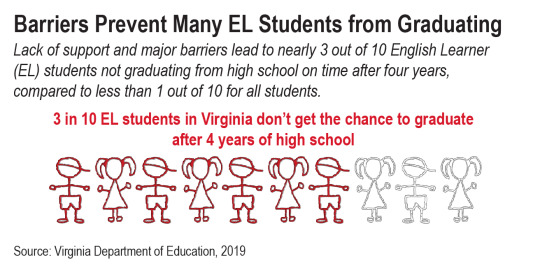November 14, 2019
Funding our Future: Stepping Up for Our English Learner Students
Every child should have access to an excellent education, and in Virginia, it is written into our constitution that the legislature will seek to ensure “an educational program of high quality.” Yet with another year of student outcome data, we have another year of confirmation that Virginia is failing to live up to its promise for our English Learner (EL) students. Year after year, the state underfunds our EL students, resulting in persistent disparities in graduation and testing outcomes for this fast growing segment of our student population. Alarmingly, disparities for EL students have grown precipitously over the past two years as the number of students needing EL services increased. It’s time for state leaders to make significant changes in how Virginia funds staffing and services for EL students to reverse this troubling trend.
Evidence is clear on the matter: adequate funding is critical for student outcomes. High quality language instruction for EL students has been shown to improve academic outcomes and language proficiency. The Virginia Board of Education (VBOE) took an important step recently by recommending vital changes to the state’s primary funding formula, the Standards of Quality (SOQ), to support EL students, including tying levels of support to student language ability (an increase in state funding of $26.7 million).
As a first step, lawmakers should start by adopting and funding VBOE’s recommendations during the upcoming legislative session in January. Persistent underfunding and the growing need for services underscores the urgent need to provide additional support for EL students. State lawmakers should also go one step further and commission a cost study to determine more realistic funding levels needed to provide EL students with an adequate education in our state.
So what is Virginia currently doing to help EL students? The state currently requires and helps pay for 17 additional instructional positions for every 1,000 EL students. This support averaged out to $563 per EL student to meet staffing standards in the SOQ for the 2018-2019 school year. Comparatively, the state spent $4,890 per student to fund the other SOQ programs that same year. That means the state spent about 11.5% more per EL student on SOQ costs than it did for non-EL students. The national average for additional state support for EL students is a 39% supplement beyond the base-state support, with neighboring states like Maryland going as high as 99% in what the state requires and helps pay for. The few other state studies on the topic find that the right range for additional state support in order for EL students to receive an adequate education is from 39% to 200%. In a comprehensive review of research on EL-funding adequacy (70 empirical studies in all), virtually every study with a recommendation indicates Virginia is falling far short of what is adequate.
With Virginia significantly underfunding EL support, it’s no wonder that recent state outcome data shows significant and persistent gaps. Most telling of the achievement gap for our EL students is the state Standards of Learning (SOL) assessments, taken annually by Virginia students (note: SOLs changed to new computer formats and standards over the years). Pass rates for EL students on the SOL reading tests were a staggering 47.5 percentage points lower than non-EL students on the most recent 2019 tests, the largest gap of any major student subgroup in state SOL data. The gap was even larger between Latinx EL and Latinx non-EL students (52 percentage points). The gap on the math test was also substantial, but smaller than reading, at 26 percentage points. And these gaps have gotten significantly worse over the past several years.

Graduation data is equally concerning. In 2019, only 7 out of 10 EL students graduated within four years of entering high school — compared to 9 out of 10 for all students. Since 2015, students who have had or currently have EL status in school have seen a 9 percentage point drop in four-year graduation rates, from over 80% to around 71% in 2019.

We also see major disparities in the number of EL students being placed in gifted programs EL students make up only 2% of Virginia’s gifted student population, even though they make up nearly 9% of the student population. At the same time, EL students remain nearly twice as likely as non-EL students to be identified for a specific learning disability in Virginia a trend which is common across the country as educators often misidentify language barriers for a disability.
Clearly the state needs to change course on how we support EL students. The VBOE’s recommendations provide an immediate foundation from which state lawmakers can stand with EL students and provide needed support. In addition to funding these recommendations, a clear next step is for Virginia lawmakers to follow the lead of other states and commission a study on what it would cost to adequately support EL students. The current status quo leaves too many EL students behind, sabotages their future opportunities, and reflects poorly on a rich state like Virginia, with plenty of resources and expertise to solve this persistent and worsening inequity.
Category:
Education
